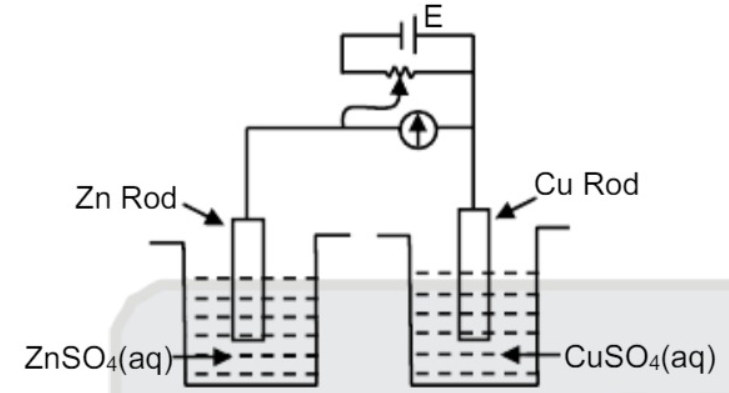Redox reactions play a pivotal role in chemistry and biology. The values of standard redox potential of two half-cell reactions decide which way the reaction is expected to proceed. A simple example is a Daniel cell in which zinc goes into solution and copper gets deposited.
of different half cells are given below:
In which cell, per "mole" of electron is most negative?
The correct Answer is:B
Step by step video, text & image solution for Redox reactions play a pivotal role in chemistry and biology. The values of standard redox potential (E^(@)) of two half-cell reactions decide which way the reaction is expected to proceed. A simple example is a Daniel cell in which zinc goes into solution and copper gets deposited. E^(@)(SRP) of different half cells are given below: E_(Cu^(2+)|Cu)^(@)=0.34V, E_(Zn^(2+)|Zn)^(@)=-0.76V E_(Ag^(+)|Ag=0.8V, E_(Mg^(2+)|Mg))=-2.37V In which cell, DeltaG^(@) per "mole" of electron is most negative? by Chemistry experts to help you in doubts & scoring excellent marks in Class 12 exams.
Topper's Solved these Questions
- BOOK - GRB PUBLICATIONCHAPTER - ELECTROCHEMISTYEXERCISE - Match the column type16videos
ELECTROCHEMISTY
- BOOK - GRB PUBLICATIONCHAPTER - ELECTROCHEMISTYEXERCISE - Subjective type39videos
ELECTROCHEMISTY
- BOOK - GRB PUBLICATIONCHAPTER - ELECTROCHEMISTYEXERCISE - Multiple objective type33videos
ELECTROCHEMISTY
- BOOK - GRB PUBLICATIONCHAPTER - D-BLOCK ELEMENTSEXERCISE - Subjective Type18videos
D-BLOCK ELEMENTS
- BOOK - GRB PUBLICATIONCHAPTER - ENVIRONMENTAL CHEMISTRY EXERCISE - Straight objective type40videos
ENVIRONMENTAL CHEMISTRY
Similar Questions
Why blue colour of CuSO4 solution gets discharged when zinc rod is dipped in it ? Given, E∘Cu+2/Cu=0.34VandE∘Zn+2/Zn=−0.76V
View SolutionRedox reactions play a vital role in chemistry and biology. The values of standard redox potential (E∘) of two half-cells reactions decide which way the reaction is expected to proceed. A simple example is a Daniell cell in which zince goes into solution and copper gets deposited. Given below are set of half-cell reactions (acidic medium ) along with their E∘ in V with respect to normal hydrogen electrode values.
l2+2e−→2l−E∘=0.54Cl2+2e−→2Cl− E∘=1.36Mn3++e−→Mn2+E2=1.50Fe3++e−→Fe2+ E∘=0.77O2+4H++4e−→2H2OE∘=1.23
Among the following, identify the correct statementView Solution
Knowledge Check
- Question 1 - Select One
Ec−.red of different half cell are given as :
Ec−.Cu2+∣Cu=0.34V,Ec−.Zn2+∣Zn=−0.76V.
Ec−.Ag⊕∣Ag=0.80V,Ec−.Mg2+∣Mg=−2.37V.
In which cell ΔGc− is most negative ?AZn∣∣Zn2+(1M)∣∣∣∣Mg2+(1M)∣∣MgBZn∣∣Zn2+(1M)∣∣∣∣Ag⊕(1M)∣∣AgCCu∣∣Cu2+(1M)∣∣∣∣Ag⊕(1M)∣∣AgDAg∣∣Ag⊕(1M)∣∣∣∣Mg2+(1M)∣∣Mg - Question 2 - Select One
Redox reactions play a pivotal role in chemistry and biology. The values of standard redox potential (E∘) of two half-cell reactions decide which way the reaction is expected to proceed. A simple example is a Daniel cell in which zinc goes into solution and copper gets deposited.
For the cell: Pt ∣∣H2(0.4atm)H+(pH=1)∣∣∣∣H+(pH=2)∣∣H2(0.1atm)∣∣ Pt, the measured potential at 25∘C is:
[Given: 2.303RT/F=0.06V, log 2=0.3]A−0.1VB−0.5VC−0.042VD−0.035V - Question 3 - Select One
E∘(SRP) of different half cell given
E∘Cu2+/Cu=0.34voltE∘Zn2+/Zn=−0.76voltE∘Ag+/Ag=0.8voltE∘Mg2+/Mg=−2.37volt
In which cell Δ∘ is most negative:-AZn(s)∣∣Zn2+(1M)∣∣∣∣Mg2+(1M)∣∣Mg(s)BZn(s)∣∣Zn2+(1M)∣∣∣∣Ag+(1M)∣∣Ag(s)CCu(s)∣∣Cu2+(1M)∣∣∣∣Ag+(1M)∣∣Ag(s)DAg(s)∣∣Ag+(1M)∣∣∣∣Mg2+(1M)∣∣Mg(s)
Redox reactions play a pivotal role in chemistry and biology. The value of standard reduction potetials (E∘) of the two half cells reactions decide which way the reaction is expected to proceed. A simple example is of Daniell cell in which zinc goes into solution and copper gets deposited. Given below are a set of half-cell reactions (acidic medium) along with with E∘ values. Using the data obtain the correct explanation to the questions that are mentioned.
I2+e−→2I−,E∘=0.54 V
Cl2+2e−→2Cl−,E∘=1.36 V
Mn2++2e−→Mn,E∘=1.50 V
Fe3++e−→Fe2+,E∘=0.77 V
O2+4H++4e−→2H2O,E∘=1.23 V.
Among the following, identify the correct statement :View SolutionRedox reactions play a vital role in chemistry and biology. The values of standard redox potential (E∘) of two half-cells reactions decide which way the reaction is expected to proceed. A simple example is a Daniell cell in which zince goes into solution and copper gets deposited. Given below are set of half-cell reactions (acidic medium ) along with their E∘ in V with respect to normal hydrogen electrode values.
l2+2e−→2l−E∘=0.54Cl2+2e−→2Cl− E∘=1.36Mn3++e−→Mn2+E2=1.50Fe3++e−→Fe2+ E∘=0.77O2+4H++4e−→2H2OE∘=1.23
while Fe3+ is stable, Mn3+ is not stable in acid solution because :View SolutionRedox reactions play a vital role in chemistry and biology. The values of standard redox potential (E∘) of two half-cells reactions decide which way the reaction is expected to proceed. A simple example is a Daniell cell in which zince goes into solution and copper gets deposited. Given below are set of half-cell reactions (acidic medium ) along with their E∘ in V with respect to normal hydrogen electrode values.
l2+2e−→2l−E∘=0.54Cl2+2e−→2Cl− E∘=1.36Mn3++e−→Mn2+E2=1.50Fe3++e−→Fe2+ E∘=0.77O2+4H++4e−→2H2OE∘=1.23
Among the following, identify the correct statementView SolutionFor the given cell arrangement identify incorrect statement
given E∘_(Cu2+/Cu) = 0.34V &E∘_(Zn2+/Zn)=−0.76V View Solution
View SolutionGiven E∘Ag⊕∣Ag=+0.80V,E∘Co2+∣Co=−0.28V,E∘Cu2+∣Cu=+0.34V,E∘Zn2+∣Zn=−0.76V
Which metal will corrode fastest?View Solution

